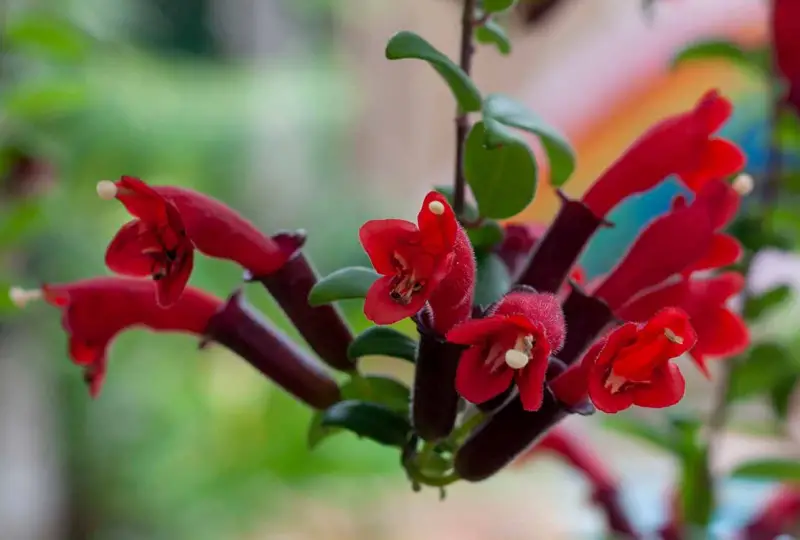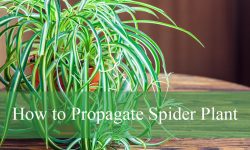Lipstick plants (Aeschynanthus radicans) are not only prized for their stunning, tubular flowers that resemble bright red or orange lipstick tubes but also for their lush, cascading foliage that can add a tropical flair to any indoor space. Originating from the humid rainforests of Southeast Asia, these flowering houseplants are relatively easy to care for, making them a favorite among both novice and experienced gardeners.
This comprehensive guide will cover everything you need to know about growing and maintaining healthy lipstick plants, from optimal light and watering conditions to tips on pruning and repotting. Whether you’re looking to brighten up your home or expand your plant collection, this guide will provide you with the essential knowledge to help your lipstick plants thrive.
About Lipstick Plants

The Lipstick Plant (Aeschynanthus radicans), also known as the lipstick vine or basket vine, is a striking perennial that belongs to the Gesneriaceae family. Native to the tropical regions of Asia, this plant is admired for its vibrant red, tubular flowers that resemble lipstick tubes, giving it its common name. The plant typically grows to a height of 2-3 feet with a spread of 1-3 feet, making it a popular choice for hanging baskets or containers where its trailing vines can cascade beautifully.
The Lipstick Plant thrives best in partial sunlight, preferring bright but indirect light to encourage blooming. It requires well-drained soil and tolerates a neutral to slightly alkaline pH. During its bloom period, which spans from spring through fall, the plant produces striking red flowers that provide a brilliant pop of color in any space.
In terms of care, this plant is suited for hardiness zones 10–11 according to the USDA, meaning it enjoys warm, humid climates and does not tolerate frost. With its lush green foliage and vivid blooms, the lipstick plant adds a tropical flair to both indoor and outdoor settings. Regular watering, good drainage, and occasional misting can help maintain its health and encourage consistent flowering.
Lipstick Plants Care
The lipstick plant, known for its vibrant, exotic blooms, is a relatively low-maintenance houseplant. To thrive, it needs bright, filtered light, making a sunny window with indirect sunlight an ideal location. This tropical beauty loves humidity, so maintaining a higher-than-average moisture level in the air will keep it happy. However, it’s essential to avoid placing it in areas prone to sudden temperature changes, as this can cause stress to the plant.
Water the lipstick plant consistently during its growing season, ensuring the soil stays moist but not waterlogged, as overwatering can lead to root rot. A well-draining, loose potting mix will help prevent this issue. Additionally, feeding the plant with diluted fertilizer regularly during the growing period will encourage lush growth and beautiful blooms.
Light
Light is a crucial factor in the healthy growth of a lipstick plant. This tropical plant thrives in bright, indirect light, mimicking the dappled sunlight it would receive in its native environment under a canopy of trees. When placed in direct sunlight for prolonged periods, its delicate leaves are prone to scorching, leading to unsightly brown patches and potential damage. On the other hand, insufficient light can hinder its growth, causing sparse foliage, leaf drop, and a lack of vibrant blooms.
To provide the ideal lighting conditions, place the lipstick plant near a window that gets plenty of natural light but is shielded from the harsh midday sun, such as an east or north-facing window. If natural light is limited, supplement with artificial grow lights to ensure the plant gets enough energy to produce its characteristic bold flowers.
Soil
In their natural tropical habitats, lipstick plants often grow in an environment with minimal soil, attaching their roots to branches or crevices in rocks where moisture is abundant but drainage is excellent. As a result, using a heavy, compacted potting soil in cultivation can easily lead to root rot due to poor drainage and excessive moisture retention. For potted lipstick plants, it’s essential to mimic their native conditions by providing a well-aerated, lightweight growing medium that allows water to drain freely while still maintaining consistent moisture.
A suitable mix often includes components like peat, sphagnum moss, and sand. Peat or sphagnum moss helps retain moisture without making the soil too soggy, while sand ensures better drainage and prevents the soil from becoming compacted over time. Incorporating these elements creates an ideal balance, keeping the roots healthy, promoting good air circulation, and preventing common issues such as overwatering. This specialized soil mix is key to encouraging robust growth and vibrant blooms in a lipstick plant.
Water
Lipstick plants thrive in consistently moist conditions, particularly during their active growing season, but they are also highly sensitive to overwatering. Excessive moisture can suffocate the roots, leading to root rot, leaf drop, and fungal issues that compromise the plant’s health. Striking the right balance between keeping the plant hydrated and avoiding waterlogged conditions is essential.
Moderate watering is the key to success. It’s important to water the plant when the top couple of inches of the potting medium feel dry to the touch, but not to let the soil dry out completely. This ensures the plant receives enough moisture without sitting in standing water. Always use a pot with drainage holes to prevent excess water from accumulating at the bottom, and if possible, water the plant more frequently during warmer months when growth is vigorous. During the cooler months, reduce watering slightly to allow the plant to rest, but never let the soil become completely parched. With the right watering routine, your lipstick plant will maintain healthy foliage and vibrant blooms.
Temperature and Humidity
Ideal temperatures for growing a healthy lipstick plant range between 65 and 75 degrees Fahrenheit, which closely mimic the warm, tropical conditions the plant naturally enjoys. When temperatures dip below 50 degrees Fahrenheit, the plant begins to experience stress, often resulting in leaf drop. As a tropical species, the lipstick plant thrives in warm, humid environments, so providing higher humidity levels is crucial for its wellbeing. Regular misting, especially in dry indoor conditions, helps maintain the necessary humidity, though it’s best to mist in the morning to prevent fungal leaf spot diseases from developing.
Sudden temperature fluctuations and drafts can also negatively affect the plant, causing stress and potentially leading to poor growth or damage. It’s important to avoid placing the lipstick plant near doors that open frequently, drafty windows, or air conditioning vents, as these can expose it to temperature shifts that hinder its health.
Fertilizer
Your lipstick plant will benefit from regular feedings of a balanced, slow-release fertilizer during its active growing season. Applying fertilizer once or twice a month helps ensure the plant receives essential nutrients for healthy growth and vibrant blooms. Be sure to dilute the fertilizer to half its recommended strength to avoid overfeeding, which can cause salt buildup and damage the plant’s roots.
During the plant’s dormant period in the cooler months, reduce or pause fertilization, as the plant’s nutrient needs decrease.
Pruning
Pruning your lipstick plant regularly helps maintain its neat, bushy appearance and encourages new, healthy growth. Trimming back the cascading stems prevents the plant from becoming straggly and overgrown. Using clean, sharp scissors or pruning shears, you can safely remove up to 1/3 of each vine, targeting any leggy or damaged areas.
Pruning also stimulates branching, leading to a fuller, more compact plant with better overall shape. It’s best to prune during the growing season to maximize recovery and new growth. Always ensure your tools are sanitized before pruning to prevent the spread of disease.
Common Pests & Plant Diseases
Lipstick plants are generally resistant to major pest problems, but they can occasionally attract pests such as aphids, mealybugs, and spider mites. These infestations are best managed by using horticultural oils or by thoroughly spraying the affected areas with water to wash the pests away.
In overly wet conditions, lipstick plants can become susceptible to fungal diseases and leaf spot. To prevent these issues, it’s important to avoid leaving the leaves damp for extended periods and to ensure the potting medium is well-draining. Proper care and moisture control will help keep the plant healthy and free from common diseases.
How to Grow Lipstick Plants From Seed?
Growing lipstick plants from seed, though less common than propagation from cuttings, is still a viable option for patient growers. To start, use a light, well-draining seed starting mix that provides the ideal environment for the seeds to sprout. Scatter the seeds on the surface of the mix, covering them only lightly, as they need some exposure to light to germinate.
Once the seeds are sown, maintain a warm, consistent temperature between 70 and 75 degrees Fahrenheit, which closely mimics the tropical conditions the plant prefers. It’s helpful to cover the container with plastic wrap or place it in a propagation tray to create a mini greenhouse effect, keeping humidity levels high. Be sure to keep the soil consistently moist but not waterlogged throughout the germination process.
With the right conditions, the seedlings should begin to germinate in approximately two weeks. Once they sprout and develop a few true leaves, they can be carefully transplanted into individual pots and treated like mature lipstick plants. While growing from seed takes more time and attention than using cuttings, it can be a rewarding way to propagate new plants.
Common Problems with Lipstick Plant
Lipstick plants are generally resilient and can maintain good health when placed in the right environment. However, if you notice certain issues, it’s important to evaluate the plant’s light, soil, and temperature conditions to ensure they are optimal for its growth.
Dropping Leaves: One common problem is leaf drop, often signified by yellowing leaves followed by shedding. This can occur if the plant is exposed to temperatures below 50 degrees Fahrenheit. It’s essential to keep the lipstick plant in a warm environment where the temperature remains stable, ideally above 60 degrees Fahrenheit for the soil, to prevent stress that leads to leaf drop.
Wilted Appearance: Another issue is a wilted or droopy appearance, which often indicates overwatering. While maintaining regular watering is crucial, it’s equally important to ensure the potting soil drains well to prevent root rot and fungal infections, which can be detrimental to the plant’s health. Additionally, adequate light is necessary to keep the plant from drooping; without sufficient light, it may not be able to photosynthesize effectively, leading to a wilting appearance.
Slow Growth: If your lipstick plant shows slow growth or appears to have stopped growing altogether during its peak season, it may be time for a change. Monitoring the roots is essential; if they start to circle the bottom of the pot or peek through the drainage holes, it indicates that the plant has become root-bound. To avoid a last-minute repotting, proactively check the root system and transfer the plant into a larger container when necessary. Addressing these common problems promptly will help keep your lipstick plant healthy and thriving.
When to Repot a Lipstick Plant?
Repotting your lipstick plant is essential when it becomes rootbound, meaning the roots have filled the container and started to circle around the bottom. This typically occurs when the plant outgrows its current pot, which can lead to stunted growth and poor health. The best time to repot is in early spring or after the plant has finished its vigorous blooming season in spring and summer, allowing it to settle into its new home before the next growth cycle begins.
Steps to Repot a Lipstick Plant
- Prepare for Repotting: Gather your materials, including a new pot (1-2 inches larger in diameter), fresh potting mix, and sterile scissors or pruning shears.
- Remove the Root Ball: Gently remove the root ball from the existing container, shaking off the old potting mix while being careful not to damage the roots.
- Inspect the Roots: Examine the root system for any dead or damaged roots.
- Trim Damaged Roots: Use sterile scissors or pruning shears to cut off any dead or damaged roots to promote healthy growth.
- Choose a New Pot: Select a new pot that is one to two inches larger than the previous one. Terracotta pots are recommended for their breathability and excellent drainage.
- Add Potting Mix: Fill the new pot with fresh, loose, well-draining potting mix, leaving enough space for the root ball.
- Place the Root Ball: Carefully position the root ball in the center of the new pot, ensuring the plant is at the same depth as it was in the old pot.
- Water the Plant: Once replanted, give the plant a good watering to help it acclimate to its new environment.
By following these steps, your lipstick plant will have the necessary space to thrive and continue producing beautiful blooms.






